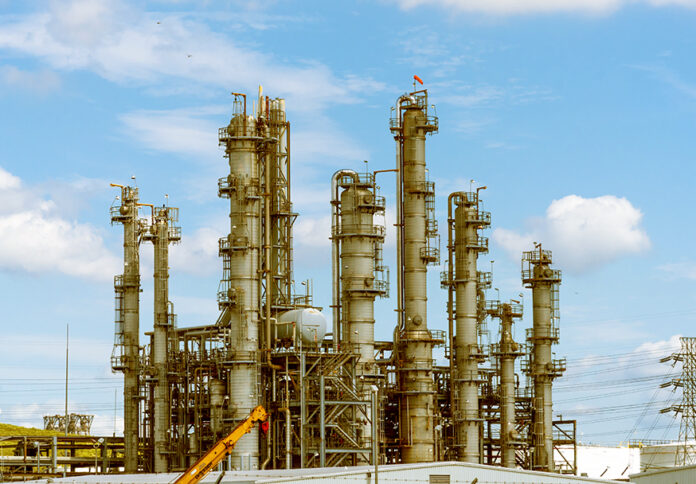U.S. refining capacity had been on a gradual upward trend in the decade before the onset of the Covid-19 pandemic in early 2020, driven by gains in efficiency and relatively small expansions of existing refineries rather than the construction of new ones.
Between January 2010 and June 2019, U.S. operable refining capacity grew from 16.9 million barrels per day (b/d) to 18.7 million b/d with an average capacity utilization of 89.4%. The decline in demand due to the pandemic caused U.S. refineries to idle or close 891,000 b/d of capacity in 2020-21.
The closures were most extensive on the East Coast, which accounted for nearly half. On the Gulf Coast, 269,000 b/d of capacity shut and on the West Coast, 216,000 b/d. By the end of 2022, U.S. operable refining capacity was 17.8 million b/d.
By April 2023, it had recovered to 18.1 million b/d, down from the pre-pandemic peak. However, capacity has yet to catch up with the post-pandemic recovery in demand. Inventory levels remain relatively low at around 800 million barrels in mid-July.
Ukraine
With the onset of the war in Ukraine, energy prices and refining margins rose strongly in 2022, resulting in more capacity being reactivated and new investment in existing sites.
The remaining U.S. refiners benefitted from low inventory levels and a lack of capacity created by the pandemic closures. As a result, they returned to expansion:
• Marathon Petroleum has expanded crude distillation capacity by 40,000 b/d at its Galveston Bay refinery in Texas. However, the refinery has experienced a fire and an oil spill this year, limiting operations. Citgo Petroleum has added 38,000 b/d capacity at its Lake Charles refinery in Louisiana.
• This year, Valero started up a new 55,000-b/d coking facility at its 335,000-b/d Port Arthur refinery, also in Texas, following an overhaul of the 115,000-b/d crude distillation unit (CDU). This will use additional residual crude from higher CDU throughput. Last year, PBF Energy reactivated a previously decommissioned 60,000-b/d CDU at its Paulsboro refinery in New Jersey.
• In March, ExxonMobil brought on stream a 250,000-b/d expansion of its Gulf Coast Beaumont refinery, the first significant refining sector capacity addition since the start of the pandemic. This reflects ExxonMobil’s willingness to spend through slumps in the investment cycle rather than a response to higher margins in 2022, as the expansion plans pre-dated the increase in margins.
Gulf Coast
Both the pandemic-related reduction of capacity and the subsequent expansions have concentrated U.S. refining capacity on the hurricane-prone coast of the Gulf of Mexico.
The Gulf Coast is attractive for refineries regardless because of the proximity of offshore production and major shale plays, well-developed export infrastructure and access to Atlantic, Pacific and Latin American markets.
U.S. exports of refined oil products have grown steadily over the last decade, from 49.5 million barrels in January 2010 to a monthly average of 95 million barrels in 2022. According to data from the U.S. Energy Information Administration, the United States has been a net exporter of crude oil and oil products each month since October 2021.
Margins Narrow
After a bumper 2022, U.S. refiners face a less lucrative but still positive outlook this year. Margins will likely narrow in the second half due to slower export demand and an additional 1.4 million b/d of new refining capacity coming on-stream worldwide. However, they should remain at the top of the historical five-year range and stay positive for the rest of this decade.
Energy Transition

The energy transition away from fossil fuels will limit new investment in capacity globally, particularly after 2024. Yet, renewable energy goals for liquid fuels are expected to lag current targets, resulting in continued substantial margins for the refining sector. The level of optimism is lower in forecasts which see a more effective and quicker energy transition.
Over-Investment
Historically the refining sector has been prone to over-investment. It made sense for crude oil producers to capture an additional part of the oil value chain. It also made sense for oil importers to do so to offset the cost of purchasing crude by retaining refining margins and exporting oil products.
Refineries also have significant strategic value in reducing the vulnerabilities inherent in dependence on imports, making them attractive to many countries, even where the economic case for investment is limited. One example is Mexico’s new Dos Bocas refinery, a project heavily pushed by President Andres Manuel Lopez Obrador, which began loading oil last month.
The prospect of slowing demand should reduce the refining sector’s tendency to overbuild, and the pandemic has already cleared out substantial inefficient capacity. In addition to the U.S. closures, more than 2 million b/d of refining capacity in Europe and parts of Asia shut during the pandemic.
Much clean energy investment in Europe, China and the United States is channeled toward electric vehicle sales. In the United States, this will primarily impact gas demand, increasing pressure on U.S. refiners to become more export oriented.
However, growth remains strong in other U.S. segments with major oil demand, such as industry, heavy-duty land transport, petrochemicals and sea and air travel.
Compared with Europe and developed Asia—including China, where oil product exports are increasing—U.S. coastal refiners should remain competitive, especially if investment in new capacity globally remains muted.


